- Department of Orthopedics, Center for Rehabilitation Medicine, Zhejiang Provincial People's Hospital (Affiliated People's Hospital, Hangzhou Medical College), Hangzhou, China
Introduction: Lateral epicondylitis is a significant clinical problem in orthopaedics. There have been numerous articles written about this. Bibliometric analysis is critical for determining a field's most influential study. We attempt to identify and analyze the top 100 citations in lateral epicondylitis research.
Materials and methods: On December 31, 2021, an electronic search was conducted in the Web of Science Core Collection and the Scopus search engine with no restrictions on publication years, language, or study design. We reviewed each article's title and abstract until the top 100 were documented and evaluated in various ways.
Results: Between 1979 and 2015, the 100 most cited articles were published in 49 journals. The total number of citations ranged from 75 to 508 (mean ± SD, 145.5 ± 90.9), with citation densities ranging from 2.2 to 37.6 citations per year (mean ± SD, 8.7 ± 6.5). The United States is the most productive country, and the 2000s witnessed a surge in lateral epicondylitis research. The year of publication had a moderately positive correlation with citation density.
Conclusion: Our findings offer readers a fresh perspective on historical development hotspot areas of lateral epicondylitis research. Disease progression, diagnosis, and management have always been topics of discussion in articles. PRP-based biological therapy has emerged as a promising area for future research.
Introduction
Lateral epicondylitis of the humerus (tennis elbow) is a common clinical condition that affects 1%–3% of adults each year (1). It is characterized by pain on the lateral part of the elbow when the patient grasps and lifts objects. According to statistics, lateral epicondylitis affects 10%–50% of tennis players (2). Workers who repeatedly exert excessive exertion for an extended period risk developing lateral epicondylitis (3). According to research, lateral epicondylitis is caused by extensor carpi radialis brevis (ECRB) or common extensor tendon (EDC) tendon degeneration rather than local inflammation (4, 5). On the other hand, the discovery of neuropeptides in the ECRB muscle suggests that neuropathic inflammation may be one of the causes of elbow pain (6, 7). According to some researchers, tennis elbow may be caused by a failure to repair the tendon and local vascular damage. Regular tendon repair can be hampered by subsequent injury, whereas damaged tendons obstruct tendon repair (8). Several studies on lateral epicondylitis have been published in articles and reviews over the last few decades, covering topics such as prevalence, pathology, injury mechanism, and treatment methods (9–11).
In recent years, bibliometric analysis has emerged in the orthopaedics literature, with various bibliometric articles ranging from rotator cuff tears to total joint arthroplasty (12–15). The citation number (the total number of times other works have cited an article since it was published) and the citation density (the citation number divided by the years since its first publication date) are commonly used to measure an article's influence on its respective specialty. While not thoroughly assessing the quality of a study, the two parameters mentioned above represent a portion of the quality of the articles published. To our knowledge, no other authors have conducted a bibliometric analysis of lateral epicondylitis. This research aimed to identify hotspots and trends in lateral epicondylitis research.
Materials and methods
Process design
The trend analysis was carried out on December 31, 2021, using the Web of Science Core Collection (Clarivate Analytics, Toronto, Canada) and the Scopus abstract and citation database (Elsevier, Amsterdam, The Netherlands). The following was the search strategy: Search for “lateral epicondylitis” in the NCBI's MeSH database. Advanced search for all search terms listed below: “Elbow, Tennis” OR “Elbows, Tennis” OR “tennis elbow” OR “Lateral Epicondylitis” OR “Epicondylitides, Lateral” OR “Epicondylitis, Lateral” OR “Lateral Epicondylitides” OR “Epicondylitis, Lateral Humeral” OR “Epicondylitides, Lateral Humeral” OR “Humeral Epicondylitides, Lateral” OR “Humeral Epicondylitis, Lateral” OR “Lateral Humeral Epicondylitides” OR “Lateral Humeral Epicondylitis” (no quotation marks) was taken using Web of Science Core Collection and the Scopus abstract and citation database search engines. Articles from all years and journals were included. A total of 2,362 articles were found in descending order based on the times they were cited in the Web of Science Core Collection. A total of 3,720 articles were found in descending order based on the times they were cited in the Scopus abstract and citation database. The top 400 kinds of literature were chosen based on citation rank; articles ranked higher than 400 were removed. Based on inclusion and exclusion criteria, two reviewers independently conducted the following reviews: Articles that meet the requirements were exported to an Excel spreadsheet. Each reviewer selected an article by reading the full text. If two researchers disagreed, the team will discuss it until they reached an agreement. Articles chosen by the two reviewers were arranged in descending order of citation frequency, and 100 articles with the highest citation frequency were selected for further investigation (Figure 1).
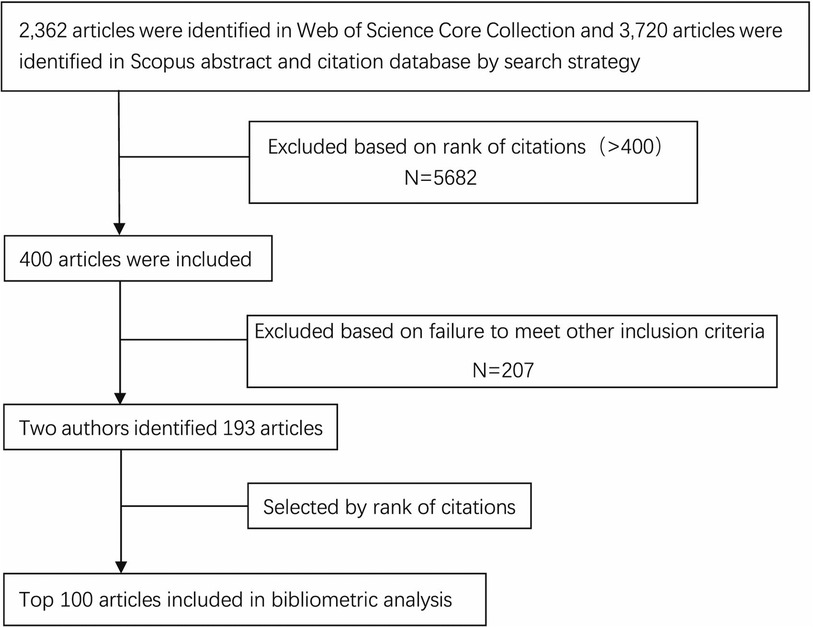
Figure 1. Flowchart illustrating the articles selection process, detailed procedures for screening and admission Note: A total of 2,362 and 3,720 articles were found in the Web of Science Core Collection and Scopus. The top 400 articles were selected according to citation frequency. Two reviewers selected 193 articles based on inclusion and exclusion criteria. The selected articles were ranked in order of citation frequency from high to low, and 100 articles with the highest citation frequency were selected for further investigation.
Inclusion and exclusion criteria
The following criteria for inclusion are (1) basic scientific research and clinical research on tennis elbow; (2) studies on diagnosis, treatment, prognosis, or prevention of tennis elbow; (3) original articles, reviews, case reports, editorials, clinical trials, and other types of papers. The exclusion criteria were as follows: (1) irrelevant to tennis elbow; (2) tennis elbow was not the primary focus of the subject; (3) the original text and other information could not be found.
For each record, the following objective data were extracted: the date of publication, the number of times cited, the number of years since publication, the citation density (defined as the average number of citations per year since publication), the source journal, the primary institution, and the country of origin (according to the address of the corresponding author). Instead of online preview publication, the date was recorded as the month and year the research was formally published in a journal. The publication date was recorded as the first of the month to calculate citation density.
For each article, the following subjective characteristics were also recorded: These details include the article type (clinical research or basic research), as well as the article subtype (clinical study subtypes: a review article, technique article, meta-analysis or systematic review, case-control, case series study, retrospective cohort study, prospective cohort study, nonrandomized controlled trial, randomized controlled trial, diagnostic study, expert opinion; preliminary study subtypes: biomechanical study, anatomic study, review article, in vitro study, animal study). Furthermore, the level of evidence for each clinical article was assessed using the classification system proposed by Wright et al. in The Journal of Joint and Bone Surgery (16). Two authors independently reviewed each article for these subjective characteristics; if there was a disagreement, a third reviewer was brought in.
Statistics
The bibliometrics software Vosviewer_1.6.17, Microsoft Office Excel (Home and Student Edition 2021), GraphPad Prism 8 (GraphPad Software Inc, CA, United States), and IBM SPSS Statistics 26.0 were used for data collection and statistical analysis. Vosviewer_1.6.17 was employed to extract essential information, create a network map of high-frequency keywords, and perform cluster analysis. The Shapiro-Wilk test was used to determine the normality of the distribution of individual variables. Data from a normal distribution are expressed as mean ± standard deviation. A one-way analysis of variance (ANOVA) was used when comparing mean values, and the Student's t-test was used when necessary. The Pearson test was used to examine the relationship between variables, and a difference of P < 0.05 was considered significant.
Results
The number of citations ranged from 75 to 508 citations (mean ± SD, 145.5 ± 90.9) for the 100 most cited articles in lateral epicondylitis research, with citation densities ranging from 2.2 to 37.6 citations per year (mean ± SD, 8.7 ± 6.5) (Supplementary Table S1).
Publication trend
The top 100 articles were published between 1979 and 2015, with most appearing in the 2000s (61 articles). The findings revealed a positive relationship between citation density and year of publication (r = +0.561, P < 0.001) (Figure 2).
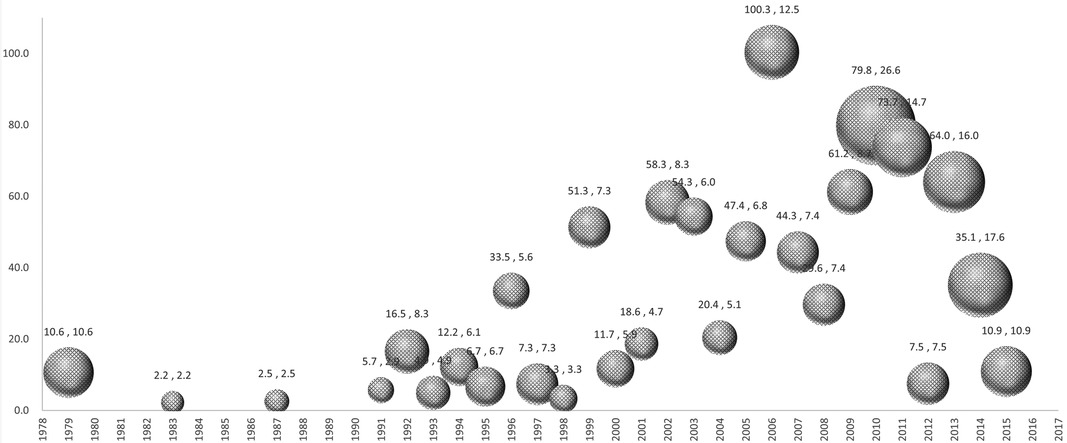
Figure 2. Bubble plot of publication year and mean citation density. Note: The X-axis represents the time range of occurrence of the top 100 cited articles, the Y-axis represents the total citation density, and the bubble size represents the average citation density of each article per year. In the data label, the former is the Y-axis value and the latter is the bubble size value.
Country distribution
The top 100 most cited articles came from 20 different countries and regions. The United States, the Netherlands, the United Kingdom, Australia, Germany, Denmark, Sweden, Finland, Canada, Wales, Belgium, Spain, France, China, New Zealand, Austria, Greece, Norway, Turkey, and Japan were the most common locations for lateral epicondylitis research articles to be published (Figure 3). The United States has been the leading country to publish articles on this subject.
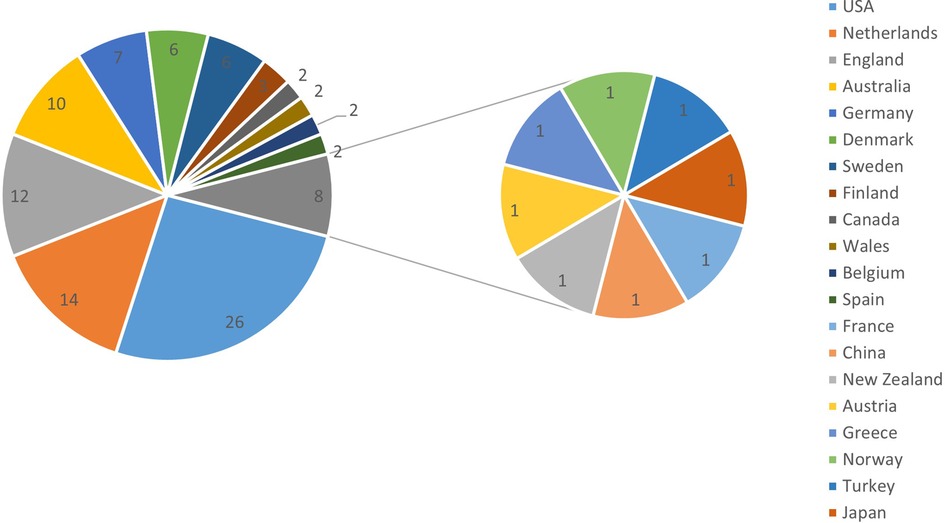
Figure 3. National distribution of the top 100 articles cited in tennis elbow. Note: the numbers in the pie chart represent the number of articles, and the different colors correspond to the countries or regions on the right.
Institution distribution and journal of publication
The University of Queensland's Institute for Research was the top contributing research center, accounting for seven top-cited articles. The American Journal of Sports Medicine was the most common place for publication, accounting for 13% of the top-cited articles.
The top 100 cited articles in tennis elbow research were published in 49 journals (Supplementary Table S2). The top three source journals on lateral epicondylitis (American Journal of Sports Medicine, British Journal of Sports Medicine, and Journal of Bone and Joint Surgery-American Volume) published 30 articles on the condition, accounting for 30% of all articles included in this study. Most articles were published in the American Journal of Sports Medicine (13), followed by the British Journal of Sports Medicine and the Journal of Bone and Joint Surgery-American Volume. The Lancet articles had the highest average citation density (28.8), followed by the American Journal of Epidemiology (21.6) and the Journal of the American Medical Association (18.7).
The author contributions and article type
In the top 100 most cited articles, Smidt, N was listed as the first author five times. With 508 citations, the most cited publication was a study by Mishra et al. Most articles were clinical research, with only 6% being basic science. The most common clinical article subtypes were randomized controlled trial (n = 26; mean ± SD number of citation density, 11.27 ± 8.18), case-control study (n = 8; mean ± SD, 11.21 ± 8.66), systematic review or meta-analysis (n = 14; mean ± SD, 10.76 ± 8.13), diagnostic study (n = 1; 9.60), in vitro study (n = 6; mean ± SD, 7.10 ± 5.39), review article (n = 15; mean ± SD, 7.20 ± 2.03), prospective cohort study (n = 9; mean ± SD, 4.91 ± 1.92), technique article (n = 1; 4.10), retrospective cohort study (n = 3; mean ± SD, 2.87 ± 0.40) (Figure 4). The one-way ANOVA (P = 0.1354) showed no significant difference between article types. According to the criteria established by Wright et al. in The Journal of Bone and Joint Surgery, level I includes randomized controlled trial; level II includes prospective cohort study and poor-quality randomized controlled trial; level III includes case-control study and a retrospective cohort study; level IV includes case series. Nearly one-third (33 articles) of the 94 clinical articles were classified as level I evidence (n = 33; mean ± SD number of citation density, 11.62 ± 8.70), level II (n = 15; mean ± SD, 5.95 ± 2.45), level III (n = 25; mean ± SD, 8.38 ± 5.67), level IV (n = 21; mean ± SD, 7.12 ± 3.97) and level V (n = 6; mean ± SD, 7.10 ± 5.39) (Figure 5). There was a significant difference between levels I and II and levels I and IV (P < 0.05).
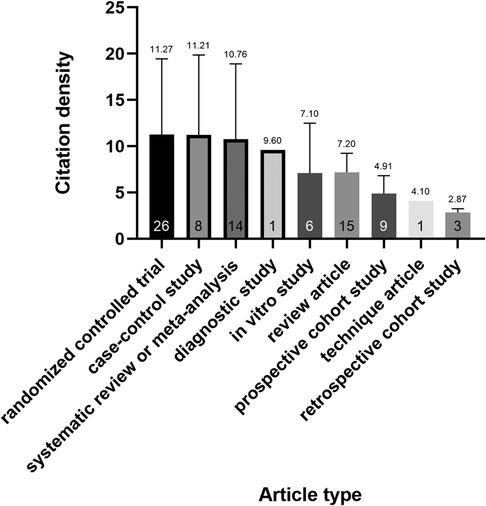
Figure 4. Mean citation density based on the article type. Note: The number at the bottom of the column represents the number of articles. there was no significant difference between article types.
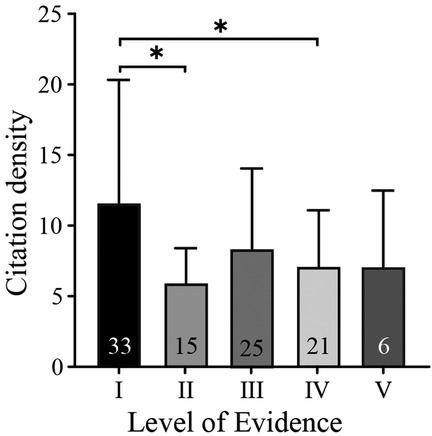
Figure 5. Mean citation density based on the level of evidence. Note: The number at the bottom of the column represents the number of articles. There was a significant difference between levels I and II and levels I and IV, * means p < 0.05.
Keywords analysis and research interest
The keywords of each article are analyzed using network analysis, as shown in the diagram (Figure 6). Only keywords that appeared more than five times are counted, and there are a total of 35 keywords; the color change from purple to yellow indicates the period from 2002 to 2010. The visual figure, tennis elbow, lateral epicondylitis, and pain had the highest degree of centrality, but by 2010, the focus had shifted to platelet-rich plasma and corticosteroid injection.
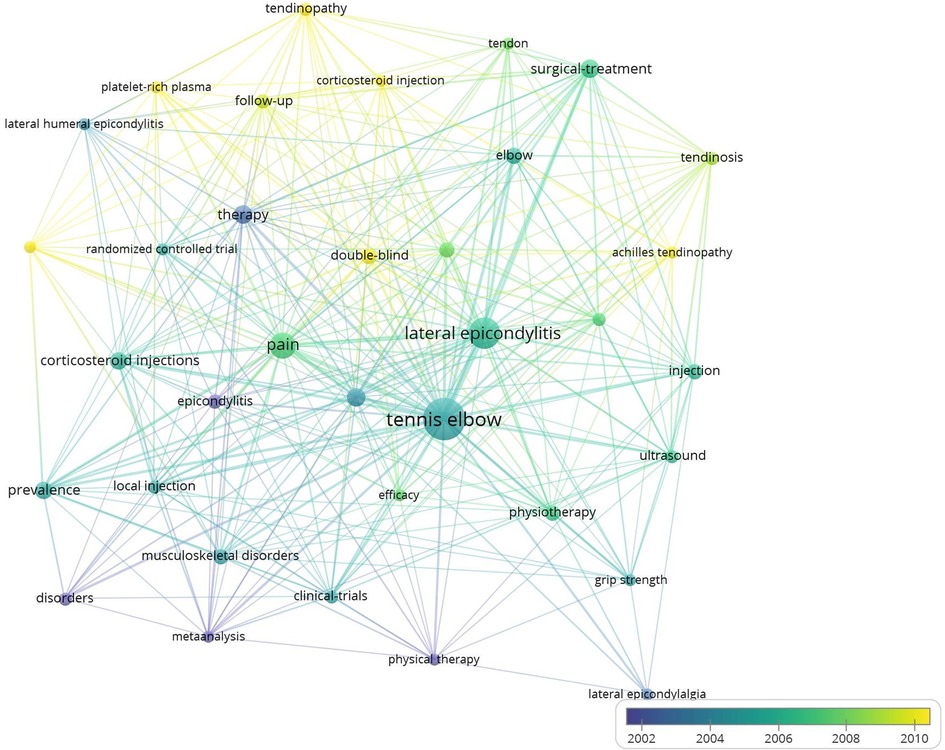
Figure 6. Network visualization map showing cluster analysis of tennis elbow related keywords. Note: The size of each circle represents the number of occurrences, and the more times, the larger the circle. In cluster analysis, different colors indicate different years.
Discussion
Bibliometric studies use a variety of methods to assess the importance of publications. One way is to use the number of citations of a given article to determine its impact on the literature. While this is not a perfect system, as even poorly done research can be frequently cited, it is still widely used to determine the impact of journals and researchers. Bibliometric studies are particularly useful when evaluating a topic with many publications. One such topic is the study of tennis elbow, which has attracted increasing interest from sports medicine surgeons and their patients. There are thousands of articles on tennis elbow in the medical literature, reflecting the intense interest in tennis elbow. One problem with such a large number of related articles is that it is almost impossible for even experts in the field, let al.one novices, to keep up with all the literature or even to identify the most important ones they need to be familiar with. For this reason, we believe that a bibliometric analysis of the tennis elbow literature is long overdue; To the best of our knowledge, no such analysis exists in the literature.
Based on our search, we found a significant increase in publications related to lateral epicondylitis over the last several decades, from 4 papers published in 1980 to 88 papers published in 2021. The current study examined the top 100 most cited articles between 1979 and 2015, and several conclusions were drawn based on our findings. First, lateral epicondylitis, also known as tennis elbow, has been a constant source of concern, with numerous articles appearing in the 21st century. Second, the disease course, anatomy, physical and accessory examination methods, and various surgical or conservative treatment methods are hotspots in this field of study. Many issues remain unresolved in the diagnosis, treatment, recurrence, and prognosis of lateral epicondylitis.
As one might expect from classical bibliometric analysis theory, papers published a few years earlier have had more possibility to accumulate citations (17). The citation density, defined as the average number of citations per year since publication, helps to compensate for this. The citation density of this list's most recently published articles is high. There is a statistically significant and moderately positive correlation between the citation density and the year of publication (P < 0.001). When the number of citations for recently published articles is considered, the most popular list must be cited more than previous articles. This discovery is, of course, intuitive. The level I and IV/V studies each account for roughly one-third of the most cited articles, indicating that low-level evidence publications in this research field are highly cited. The article publication dates in our analysis are roughly bell-shaped, with a peak around 2003. This period could be associated with the peak epidemic of lateral epicondylitis research. In terms of distribution by country/region, the United States and the Netherlands are the two leading countries. Dr. Smidt N's group published the most articles (five) between 2002 and 2006, focusing on conservative treatment of lateral epicondylitis (18–22). According to JCR, the top ten journals publishing articles on lateral epicondylitis were mostly medical journals, with only one sports science journal among the top ten. Most of these top ten journals were classified as SCI quantile 1 or 2, giving them more credibility for future researchers to study and cite.
The articles on our most-cited list provide insights into the history of lateral epicondylitis research and may aid in documenting its evolutionary course over time. Dr. Mishra's top-cited article was one of the most influential articles that sought platelet-rich plasma (PRP) treatment for chronic elbow tendinosis (23). The first, from 1973, was published in The Journal of Bone and Joint Surgery-American volume describing the effect of surgery on tennis elbow at the time (24). Tennis elbow surgery resulted in an overall improvement rate of 97.7%, with 85.2% of patients returning to complete activities, including vigorous exercise. As the disease became more widely known, various methods for diagnosing and treating it appeared and were reported in the early 1990s (5, 8, 25, 26). Local corticosteroid injection and low-energy extracorporeal shock became popular tennis elbow treatment methods in the late 1990s (27–30). Dr. Baker, CL et al. were the first of 100 articles to include an arthroscopic release in alternative management (31). More researchers focused on biological methods in the 21st century, as injection of PRP (platelet-rich plasma) and botulinum toxin became popular in more extensive multicenter randomized trials by Dr. Thanasas et al. Dr. Peerbooms et al. and Dr. Wong et al. (32–34). However, according to Dr. Robert-systematic Jan's review, there is strong evidence that PRP injection is ineffective in treating chronic lateral elbow tendinopathy (35). Workload and strain have long been studied for their potential link to morbidity, but agreement among studies has been elusive.
There are a few limitations to this study. Firstly, more recent and influential articles may not appear in the top 100 most cited lists because the more recent publications may have a problem accumulating references due to a lack of time. Secondly, self-citation may distort the number of citations and the citation density index, overestimating the impact of a specific publication in a particular field. A more precise bibliometric analysis method is required to take this into account.
Data availability statement
The datasets presented in this study can be found in online repositories. The names of the repository/repositories and accession number(s) can be found in the article/Supplementary Material.
Ethics statement
Ethical review and approval was not required for the study on human participants in accordance with the local legislation and institutional requirements. Written informed consent for participation was not required for this study in accordance with the national legislation and the institutional requirements.
Author contributions
All the authors made an effort to get the article published. All authors contributed to the article and approved the submitted version.
Acknowledgments
This work was supported in part by Zhejiang Provincial Basic Public Welfare Research Program (No. LGF20H280011); (LGF22H060029), National Natural Science Foundation of China (Grant No. 81672769), Zhejiang, Provincial Science and Technology Program of Traditional Medicine (No. 2020ZQ003) and Medical Health Science and Technology Project of Zhejiang Provincial Health Commission (2020RC043); (2021KY028).
Conflict of interest
The authors declare that the research was conducted in the absence of any commercial or financial relationships that could be construed as a potential conflict of interest.
Publisher's note
All claims expressed in this article are solely those of the authors and do not necessarily represent those of their affiliated organizations, or those of the publisher, the editors and the reviewers. Any product that may be evaluated in this article, or claim that may be made by its manufacturer, is not guaranteed or endorsed by the publisher.
Supplementary material
The Supplementary Material for this article can be found online at: https://www.frontiersin.org/articles/10.3389/fsurg.2022.913818/full#supplementary-material.
References
1. Shiri R, Viikari-Juntura E, Varonen H, Heliövaara M. Prevalence and determinants of lateral and medial epicondylitis: a population study. Am J Epidemiol. (2006) 164(11):1065–74. doi: 10.1093/aje/kwj325
2. Abrams GD, Renstrom PA, Safran MR. Epidemiology of musculoskeletal injury in the tennis player. Br J Sports Med. (2012) 46(7):492–98. doi: 10.1136/bjsports-2012-091164
3. Herquelot E, Guéguen A, Roquelaure Y, Bodin J, Sérazin C, Ha C, et al. Work-related risk factors for incidence of lateral epicondylitis in a large working population. Scand J Work Environ Health. (2013) 39(6):578–88. doi: 10.5271/sjweh.3380
4. Calfee RP, Patel A, DaSilva MF, Akelman E. Management of lateral epicondylitis: current concepts. J Am Acad Orthop Surg. (2008) 16(1):19–29. doi: 10.5435/00124635-200801000-00004
5. Chard MD, Cawston TE, Riley GP, Gresham GA, Hazleman BL. Rotator cuff degeneration and lateral epicondylitis: a comparative histological study. Ann Rheum Dis. (1994) 53(1):30–4. doi: 10.1136/ard.53.1.30
6. Han SH, An HJ, Song JY, Shin DE, Kwon YD, Shim JS, Lee SC. Effects of corticosteroid on the expressions of neuropeptide and cytokine mRNA and on tenocyte viability in lateral epicondylitis. J Inflamm (Lond). (2012) 9(1):40. doi: 10.1186/1476-9255-9-40
7. Ljung B-O, Alfredson H, Forsgren S. Neurokinin 1-receptors and sensory neuropeptides in tendon insertions at the medial and lateral epicondyles of the humerus. Studies on tennis elbow and medial epicondylalgia. J Orthop Res. (2004) 22(2):321–27. doi: 10.1016/S0736-0266(03)00183-9
8. Regan W, Wold LE, Coonrad R, Morrey BF. Microscopic histopathology of chronic refractory lateral epicondylitis. Am J Sports Med. (1992) 20(6):746–49. doi: 10.1177/036354659202000618
9. Ahmad Z, Siddiqui N, Malik SS, Abdus-Samee M, Tytherleigh-Strong G, Rushton N. Lateral epicondylitis: a review of pathology and management. Bone Joint J. (2013) 95-B(9):1158–64. doi: 10.1302/0301-620X.95B9.29285
10. Stasinopoulos D, Johnson MI. Cyriax physiotherapy for tennis elbow/lateral epicondylitis. Br J Sports Med. (2004) 38(6):675–77. doi: 10.1136/bjsm.2004.013573
11. Tosti R, Jennings J, Sewards JM. Lateral epicondylitis of the elbow. Am J Med. (2013) 126(4):357–e1-57.e6. doi: 10.1016/j.amjmed.2012.09.018
12. Kraeutler MJ, Freedman KB, MacLeod RA, Schrock JB, Tjoumakaris FP, McCarty EC. The 50 most cited articles in rotator cuff repair research. Orthopedics. (2016) 39(6):e1045–e51. doi: 10.3928/01477447-20160714-01
13. Wang S-Q, Gao Y-Q, Zhang C, Xie Y-J, Wang J-X, Xu F-Y. A bibliometric analysis using CiteSpace of publications from 1999 to 2018 on patient rehabilitation after total knee arthroplasty. Med Sci Monit. (2020) 26:e920795. doi: 10.12659/MSM.920795
14. Mavrogenis AF, Megaloikonomos PD, Panagopoulos GN, Mauffrey C, Quaile A, Scarlat MM. Best one hundred papers of international orthopaedics: a bibliometric analysis. Int Orthop. (2017) 41(4):689–97. doi: 10.1007/s00264-016-3376-z
15. Ren B, Lv X, Tu C, Li Z. Research trends of platelet-rich plasma application in orthopaedics from 2002 to 2020: a bibliometric analysis. Int Orthop. (2021) 45(11):2773–90. doi: 10.1007/s00264-021-05163-6
16. Wright JG, Swiontkowski MF, Heckman JD. Introducing levels of evidence to the journal. J Bone Joint Surg Am. (2003) 85(1):1–3. doi: 10.2106/00004623-200301000-00001
17. Huo Y-q, Pan X-h, Li Q-b, Wang X-q, Jiao X-j, Jia Z-w, et al. Fifty top-cited classic papers in orthopedic elbow surgery: a bibliometric analysis. Int J Surg. (2015) 18:28–33. doi: 10.1016/j.ijsu.2015.03.020
18. Smidt N, Assendelft WJJ, Arola H, Malmivaara A, Green S, Buchbinder R, et al. Effectiveness of physiotherapy, for lateral epicondylitis: a systematic review. Ann Med. (2003) 35(1):51–62. doi: 10.1080/07853890310004138
19. Smidt N, Assendelft WJJ, Van der Windt DAWM, Hay EM, Buchbinder R, Bouter LM. Corticosteroid injections for lateral epicondylitis: a systematic review. Pain. (2002) 96(1-2):23–40. doi: 10.1016/S0304-3959(01)00388-8
20. Smidt N, Lewis M, Van Der Windt DAWM, Hay EM, Bouter LM, Croft P. Lateral epicondylitis in general practice: course and prognostic indicators of outcome. J Rheumatol. (2006) 33(10):2053–59. PMID 1688109516881095
21. Smidt N, van der Windt DA, Assendelft WJ, Mourits AJ, Devillé WL, de Winter AF, et al. Interobserver reproducibility of the assessment of severity of complaints, grip strength, and pressure pain threshold in patients with lateral epicondylitis. Arch Phys Med Rehabil. (2002) 83(8):1145–50. doi: 10.1053/apmr.2002.33728
22. Smidt N, Van Der Windt DAWM, Assendelft WJJ, Devillé WLJM, Korthals-de Bos IBC, Bouter LM. Corticosteroid injections, physiotherapy, or a wait-and-see policy for lateral epicondylitis: a randomised controlled trial. Lancet. (2002) 359(9307):657–62. doi: 10.1016/S0140-6736(02)07811-X
23. Mishra A, Pavelko T. Treatment of chronic elbow tendinosis with buffered platelet-rich plasma. Am J Sports Med. (2006) 34(11):1774–78. doi: 10.1177/0363546506288850
24. Nirschl RP, Pettrone FA. Tennis elbow. The surgical treatment of lateral epicondylitis. J Bone Joint Surg Am. (1979) 61(6A):832–39. doi: 10.2106/00004623-197961060-00005
25. Nirschl RP. Elbow tendinosis/tennis elbow. Clin Sports Med. (1992) 11(4):851–70. doi: 10.1016/S0278-5919(20)30489-0
26. Verhaar JA. Tennis elbow. Anatomical, epidemiological and therapeutic aspects. Int Orthop. (1994) 18(5):263–67. doi: 10.1007/BF00180221
27. Hay EM, Paterson SM, Lewis M, Hosie G, Croft P. Pragmatic randomised controlled trial of local corticosteroid injection and naproxen for treatment of lateral epicondylitis of elbow in primary care. Br Med J. (1999) 319(7215):964–68. doi: 10.1136/bmj.319.7215.964
28. Haupt G. Use of extracorporeal shock waves in the treatment of pseudarthrosis, tendinopathy and other orthopedic diseases. J Urol. (1997) 158(1):4–11. doi: 10.1097/00005392-199707000-00003
29. Verhaar JA, Walenkamp GH, van Mameren H, Kester AD, van der Linden AJ. Local corticosteroid injection versus cyriax-type physiotherapy for tennis elbow. J Bone Joint Surg Br. (1996) 78(1):128–32. doi: 10.1302/0301-620X.78B1.0780128
30. Assendelft WJ, Hay EM, Adshead R, Bouter LM. Corticosteroid injections for lateral epicondylitis: a systematic overview. Br J Gen Pract. (1996) 46(405):209–16. PMID: 87035218703521
31. Baker CL, Murphy KP, Gottlob CA, Curd DT. Arthroscopic classification and treatment of lateral epicondylitis: two-year clinical results. J Shoulder Elbow Surg. (2000) 9(6):475–82. doi: 10.1067/mse.2000.108533
32. Thanasas C, Papadimitriou G, Charalambidis C, Paraskevopoulos I, Papanikolaou A. Platelet-rich plasma versus autologous whole blood for the treatment of chronic lateral elbow epicondylitis: a randomized controlled clinical trial. Am J Sports Med. (2011) 39(10):2130–34. doi: 10.1177/0363546511417113
33. Peerbooms JC, Sluimer J, Bruijn DJ, Gosens T. Positive effect of an autologous platelet concentrate in lateral epicondylitis in a double-blind randomized controlled trial: platelet-rich plasma versus corticosteroid injection with a 1-year follow-up. Am J Sports Med. (2010) 38(2):255–62. doi: 10.1177/0363546509355445
34. Wong SM, Hui ACF, Tong PY, Poon DWF, Yu E, Wong LKS. Treatment of lateral epicondylitis with botulinum toxin: a randomized, double-blind, placebo-controlled trial. Ann Intern Med. (2005) 143(11):793–97. doi: 10.7326/0003-4819-143-11-200512060-00007
Keywords: lateral epicondylitis, bibliometric analysis, citations, tennis elbow, top papers
Citation: Zhu S, He Z, Bi Q, Cao L, Gu H, Zhang Q and Chai F (2023) The 100 most cited articles in lateral epicondylitis research: A bibliometric analysis. Front. Surg. 9:913818. doi: 10.3389/fsurg.2022.913818
Received: 6 April 2022; Accepted: 28 December 2022;
Published: 13 February 2023.
Edited by:
P. Bryant Chase, Florida State University, United StatesReviewed by:
Kailiang Zhou, The Second Affiliated Hospital and Yuying Children's Hospital of Wenzhou Medical University, ChinaJiangyu Cai, Shanghai Jiao Tong University, China
© 2023 Zhu, He, Bi, Cao, Gu, Zhang and Chai. This is an open-access article distributed under the terms of the Creative Commons Attribution License (CC BY). The use, distribution or reproduction in other forums is permitted, provided the original author(s) and the copyright owner(s) are credited and that the original publication in this journal is cited, in accordance with accepted academic practice. No use, distribution or reproduction is permitted which does not comply with these terms.
*Correspondence: Fang Chai amtjaGFpMjdAZ21haWwuY29t
Specialty Section: This article was submitted to Orthopedic Surgery, a section of the journal Frontiers in Surgery
 Senbo Zhu
Senbo Zhu Zeju He
Zeju He Qing Bi
Qing Bi Fang Chai
Fang Chai